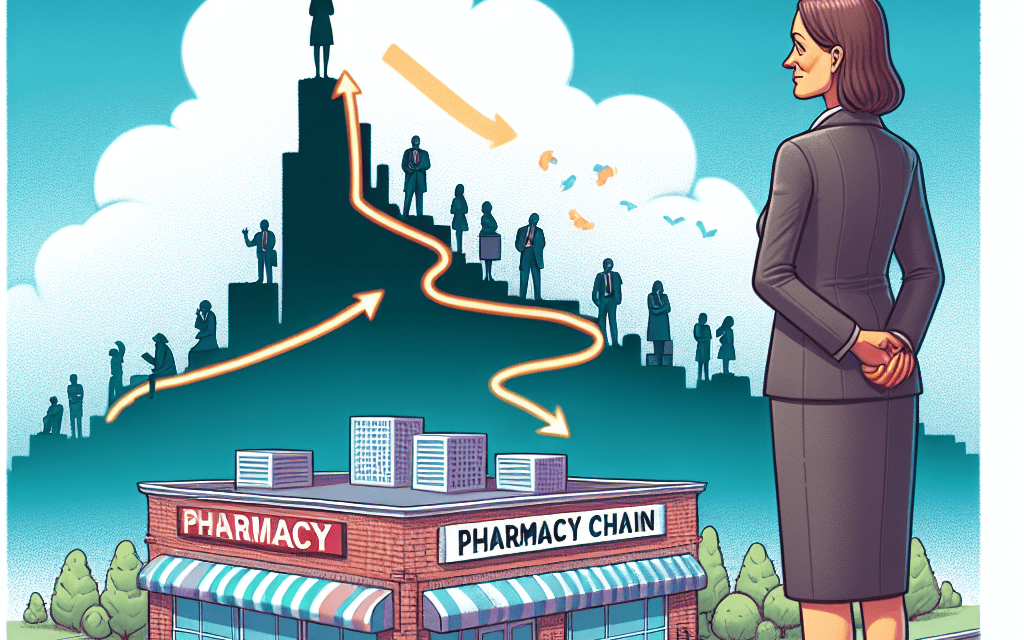“From Pinnacle to Plummet: The Swift Descent of CVS Under Karen Lynch”
Introduction
“The Rise and Fall of CVS Under CEO Karen Lynch: A Rapid Unraveling” explores the tumultuous period during which Karen Lynch helmed CVS Health, a leading American healthcare company. Appointed as CEO in February 2021, Lynch’s tenure was marked by ambitious strategic initiatives aimed at transforming CVS from a traditional pharmacy chain into a comprehensive healthcare provider. Despite initial successes, including the expansion of health services and digital innovations, the company faced significant challenges. These included operational missteps, competitive pressures, and evolving market dynamics, which ultimately led to a swift decline in performance and reputation. This narrative delves into the complexities of leadership, the volatile nature of the healthcare industry, and the lessons learned from a rapid corporate descent.
Leadership Decisions: Karen Lynch’s Strategic Moves at CVS
Karen Lynch’s tenure as CEO of CVS Health marked a period of significant transformation and turbulence for the healthcare giant. Appointed in February 2021, Lynch was tasked with steering the company through the complexities of a rapidly evolving healthcare landscape. Her leadership was characterized by bold strategic moves aimed at expanding CVS’s footprint beyond its traditional pharmacy roots. However, these decisions, while ambitious, ultimately led to a series of challenges that contributed to the company’s decline.
Under Lynch’s leadership, CVS embarked on an aggressive strategy to diversify its services. Recognizing the growing demand for integrated healthcare solutions, she championed the expansion of CVS’s HealthHUBs, which offered a range of health services, including primary care, chronic disease management, and wellness programs. This initiative was designed to transform CVS from a pharmacy chain into a comprehensive healthcare provider, positioning it to compete with other industry giants like Walgreens and Amazon. The HealthHUBs were initially well-received, as they promised to deliver convenient, accessible healthcare to communities across the United States.
In addition to expanding healthcare services, Lynch also focused on digital innovation. She prioritized the development of CVS’s digital health platform, aiming to enhance the customer experience through telehealth services and personalized health management tools. This move was in line with the broader industry trend towards digitalization, as consumers increasingly sought virtual healthcare options, especially in the wake of the COVID-19 pandemic. By investing in technology, Lynch hoped to capture a larger share of the digital health market and drive long-term growth for CVS.
However, despite these forward-thinking strategies, Lynch’s tenure was not without its challenges. The rapid expansion of HealthHUBs proved to be a double-edged sword. While the concept was innovative, the execution faced significant hurdles. The integration of new services into existing stores was more complex and costly than anticipated, leading to operational inefficiencies and strained resources. Moreover, the ambitious rollout stretched CVS’s workforce thin, resulting in staffing shortages and impacting the quality of customer service.
Furthermore, Lynch’s focus on digital transformation, though visionary, encountered obstacles. The digital health platform faced technical issues and struggled to gain traction among consumers who were already loyal to established telehealth providers. This hindered CVS’s ability to fully capitalize on the growing demand for virtual healthcare services.
Compounding these operational challenges were external factors that further complicated Lynch’s strategic plans. The healthcare industry was undergoing significant regulatory changes, and CVS faced increased competition from both traditional and non-traditional players. Amazon’s entry into the pharmacy business, for instance, intensified the competitive landscape, putting additional pressure on CVS to differentiate itself.
As these challenges mounted, CVS’s financial performance began to falter. The company’s stock price, which had initially surged under Lynch’s leadership, started to decline as investors grew wary of the mounting operational issues and competitive pressures. Despite her efforts to pivot the company towards a more integrated healthcare model, Lynch’s strategic moves ultimately fell short of delivering the desired results.
In conclusion, Karen Lynch’s leadership at CVS was marked by a series of ambitious strategic decisions that sought to redefine the company’s role in the healthcare industry. While her vision for a more integrated and digitalized CVS was forward-thinking, the execution of these strategies faced significant hurdles. The rapid expansion and digital transformation initiatives, coupled with external competitive pressures, contributed to the company’s decline, highlighting the complexities and risks inherent in navigating a rapidly changing healthcare landscape.
Financial Performance: Analyzing CVS’s Market Position
Under the leadership of CEO Karen Lynch, CVS Health experienced a period of significant transformation, marked by both ambitious expansion and unexpected challenges. Initially, Lynch’s tenure was characterized by strategic initiatives aimed at solidifying CVS’s market position as a healthcare giant. Her vision was to integrate health services more deeply into the company’s retail operations, thereby creating a seamless experience for consumers. This approach was intended to leverage CVS’s extensive network of pharmacies and clinics to provide comprehensive care, ranging from prescription services to primary care consultations.
In the early stages of Lynch’s leadership, CVS’s financial performance appeared robust. The company reported steady revenue growth, driven by increased demand for healthcare services and a strategic focus on expanding its HealthHUB locations. These hubs were designed to offer a wide array of health services, including chronic disease management and wellness programs, which were expected to drive foot traffic and increase customer loyalty. Moreover, the acquisition of Aetna, a major health insurer, was seen as a pivotal move to diversify CVS’s revenue streams and enhance its competitive edge in the healthcare sector.
However, as the market dynamics evolved, CVS faced mounting challenges that began to unravel its financial stability. One significant factor was the intensifying competition from other retail giants and online platforms entering the healthcare space. Companies like Amazon and Walmart started offering similar services, often at lower prices, which eroded CVS’s market share. Additionally, the regulatory landscape became increasingly complex, with new policies affecting drug pricing and reimbursement rates, further squeezing CVS’s profit margins.
Another critical issue was the integration of Aetna, which proved to be more complex and costly than initially anticipated. The synergies expected from the merger did not materialize as quickly as projected, leading to operational inefficiencies and increased expenses. This situation was exacerbated by the COVID-19 pandemic, which, while initially boosting demand for healthcare services, also disrupted supply chains and increased operational costs. The pandemic highlighted vulnerabilities in CVS’s business model, particularly its reliance on physical locations at a time when digital health solutions were gaining traction.
As these challenges mounted, investor confidence in CVS began to wane. The company’s stock performance reflected growing concerns about its ability to adapt to the rapidly changing healthcare landscape. Analysts pointed to the need for CVS to accelerate its digital transformation efforts and streamline its operations to remain competitive. Despite efforts to address these issues, including cost-cutting measures and investments in technology, the company’s financial performance continued to lag behind expectations.
In conclusion, the rise and fall of CVS under CEO Karen Lynch illustrate the complexities of navigating the healthcare industry in a time of rapid change. While Lynch’s strategic vision initially positioned CVS as a leader in integrated healthcare services, unforeseen challenges and competitive pressures ultimately led to a rapid unraveling of its market position. The experience underscores the importance of agility and innovation in maintaining financial stability and market relevance in an increasingly competitive environment. As CVS looks to the future, it will need to reassess its strategies and adapt to the evolving needs of consumers to regain its footing in the healthcare sector.
Competitive Landscape: CVS’s Battle with Rivals
Under the leadership of CEO Karen Lynch, CVS Health embarked on a transformative journey, aiming to redefine its position within the competitive landscape of the healthcare and retail pharmacy sectors. Initially, Lynch’s strategic vision appeared promising, as she sought to integrate CVS’s extensive retail network with its burgeoning healthcare services. This approach was designed to create a seamless experience for consumers, offering everything from prescription medications to primary care services under one roof. However, as the company navigated this ambitious path, it faced formidable challenges from both traditional rivals and emerging disruptors, leading to a rapid unraveling of its competitive edge.
In the early stages of Lynch’s tenure, CVS’s primary competitors included Walgreens Boots Alliance and Rite Aid, both of which were also striving to adapt to the evolving healthcare environment. Walgreens, in particular, was aggressively expanding its healthcare offerings, forming strategic partnerships and investing in technology to enhance its service delivery. Meanwhile, Rite Aid, though smaller in scale, was focusing on niche markets and personalized customer experiences to maintain its relevance. Despite these challenges, CVS initially managed to maintain its market position through its extensive network of retail locations and its acquisition of Aetna, a major health insurer, which was intended to bolster its healthcare services.
However, the competitive landscape soon shifted with the entry of non-traditional players such as Amazon and Walmart, both of which began to make significant inroads into the healthcare sector. Amazon’s acquisition of PillPack and its subsequent launch of Amazon Pharmacy posed a direct threat to CVS’s core pharmacy business. With its vast logistics network and customer-centric approach, Amazon was well-positioned to offer competitive pricing and convenience, drawing customers away from traditional brick-and-mortar pharmacies. Similarly, Walmart leveraged its extensive retail footprint and low-cost model to expand its healthcare services, including walk-in clinics and telehealth offerings, further intensifying the competition.
As these new entrants gained traction, CVS struggled to differentiate itself and maintain its market share. The company’s efforts to integrate its retail and healthcare services faced operational challenges, leading to inefficiencies and customer dissatisfaction. Additionally, the rapid pace of technological advancements in the industry required significant investments in digital infrastructure, which strained CVS’s resources and diverted attention from its core operations. Consequently, CVS found itself in a precarious position, caught between the need to innovate and the pressure to deliver consistent financial performance.
Moreover, the COVID-19 pandemic accelerated changes in consumer behavior, with a growing preference for online shopping and telehealth services. This shift further eroded CVS’s competitive advantage, as its traditional retail model struggled to adapt to the new normal. While the company made efforts to enhance its digital offerings, including the expansion of its telehealth platform and the introduction of home delivery services, these initiatives were often reactive rather than proactive, allowing competitors to capture market share.
In conclusion, the rise and fall of CVS under CEO Karen Lynch can be attributed to a combination of strategic missteps and an increasingly competitive landscape. While Lynch’s vision of integrating retail and healthcare services was ambitious, the execution fell short in the face of mounting challenges from both traditional rivals and innovative disruptors. As CVS continues to navigate this complex environment, it must find ways to leverage its strengths and adapt to the rapidly changing market dynamics to regain its competitive footing.
Innovation and Technology: CVS’s Digital Transformation

Under the leadership of CEO Karen Lynch, CVS Health embarked on an ambitious journey to transform its digital landscape, aiming to redefine the healthcare experience for millions of Americans. This digital transformation was not merely a strategic pivot but a necessary evolution in response to the rapidly changing healthcare environment and consumer expectations. As the world increasingly embraced digital solutions, CVS sought to position itself at the forefront of this shift, leveraging technology to enhance its service offerings and streamline operations.
Initially, the digital transformation strategy appeared promising. CVS invested heavily in developing a robust digital infrastructure, which included the enhancement of its mobile app and website to provide a seamless user experience. The company introduced features such as telehealth services, digital prescription management, and personalized health recommendations, all designed to make healthcare more accessible and convenient for its customers. These innovations were well-received, as they addressed the growing demand for remote healthcare solutions, particularly during the COVID-19 pandemic when in-person visits were often not feasible.
Moreover, CVS’s digital initiatives extended beyond customer-facing applications. The company also focused on integrating advanced data analytics and artificial intelligence into its operations. This integration aimed to optimize supply chain management, improve inventory accuracy, and enhance decision-making processes. By harnessing the power of data, CVS sought to predict consumer needs more accurately and tailor its offerings accordingly, thereby gaining a competitive edge in the market.
However, despite these promising developments, the digital transformation under Karen Lynch’s leadership faced significant challenges that ultimately contributed to the company’s rapid unraveling. One of the primary issues was the execution of these digital strategies. While the vision was clear, the implementation was fraught with difficulties. Technical glitches, system outages, and cybersecurity concerns plagued the rollout of new digital platforms, leading to customer dissatisfaction and eroding trust in the brand.
Furthermore, the rapid pace of technological change outstripped CVS’s ability to adapt. Competitors in the healthcare and retail sectors were also investing in digital solutions, often with greater agility and success. This increased competition put additional pressure on CVS to deliver results quickly, sometimes at the expense of thorough testing and quality assurance. As a result, the company’s digital offerings, while innovative, often fell short of expectations.
Another critical factor in the unraveling of CVS’s digital transformation was the internal resistance to change. The shift towards a more technology-driven approach required a cultural transformation within the organization, which proved challenging. Employees accustomed to traditional methods were often reluctant to embrace new technologies, leading to inefficiencies and a lack of cohesion in executing the digital strategy.
In conclusion, while Karen Lynch’s tenure as CEO of CVS Health was marked by a bold vision for digital transformation, the execution of this vision faced numerous obstacles. The initial promise of a digitally enhanced healthcare experience was undermined by technical challenges, competitive pressures, and internal resistance. As a result, the rapid unraveling of CVS’s digital transformation serves as a cautionary tale for other organizations embarking on similar journeys. It underscores the importance of not only having a clear strategic vision but also ensuring meticulous execution, fostering a culture of innovation, and maintaining the flexibility to adapt to an ever-evolving technological landscape.
Customer Experience: Changes Under Karen Lynch’s Tenure
Under the leadership of CEO Karen Lynch, CVS Health embarked on a transformative journey that significantly altered the customer experience. Lynch, who took the helm in February 2021, aimed to redefine the company’s approach to healthcare delivery and customer engagement. Her tenure was marked by ambitious initiatives intended to enhance the customer experience, yet these changes also faced challenges that contributed to a rapid unraveling of her vision.
Initially, Lynch’s strategy focused on integrating CVS’s vast network of retail pharmacies with its health insurance arm, Aetna, to create a seamless healthcare ecosystem. This integration was designed to provide customers with a more holistic approach to health management, offering everything from prescription services to insurance coverage under one roof. By leveraging data analytics, CVS aimed to personalize customer interactions, tailoring services to individual health needs and preferences. This approach promised to revolutionize the way customers interacted with their healthcare providers, making it more convenient and efficient.
Moreover, Lynch prioritized the expansion of HealthHUBs, which are enhanced store formats offering a wide range of health services, including chronic disease management, wellness products, and on-site medical care. These hubs were intended to transform CVS locations into community health destinations, providing customers with easy access to comprehensive care. The concept was well-received initially, as it aligned with the growing consumer demand for accessible and integrated healthcare solutions.
However, despite these promising initiatives, several factors contributed to the challenges faced by CVS under Lynch’s leadership. One significant issue was the execution of these ambitious plans. While the vision was clear, the implementation often fell short due to logistical complexities and operational inefficiencies. For instance, the integration of Aetna’s services with CVS’s retail operations proved to be more complicated than anticipated, leading to delays and customer dissatisfaction.
Additionally, the rapid expansion of HealthHUBs encountered obstacles, such as staffing shortages and inconsistent service quality across locations. These issues undermined the customer experience, as patients seeking reliable and timely care were sometimes met with long wait times and limited service availability. Consequently, the initial excitement surrounding the HealthHUB concept began to wane, as customers faced frustrations that contradicted the promise of enhanced convenience.
Furthermore, the competitive landscape of the healthcare industry posed challenges for CVS. Rivals such as Walgreens and Amazon were also making strides in integrating technology and expanding their healthcare offerings, intensifying the pressure on CVS to deliver on its promises. This competition highlighted the need for CVS to not only innovate but also execute its strategies flawlessly to maintain customer loyalty and market share.
In conclusion, while Karen Lynch’s tenure as CEO of CVS Health was marked by a bold vision to transform the customer experience, the rapid unraveling of her initiatives underscores the complexities of executing large-scale changes in the healthcare sector. The integration of services and expansion of HealthHUBs were promising steps towards a more integrated healthcare model, yet operational challenges and competitive pressures hindered their success. As CVS continues to navigate these challenges, the lessons learned from Lynch’s tenure will undoubtedly shape the company’s future strategies in enhancing customer experience.
Regulatory Challenges: Navigating Healthcare Policies
Under the leadership of CEO Karen Lynch, CVS Health embarked on an ambitious journey to redefine its role in the healthcare sector. However, the company’s trajectory was not without its challenges, particularly in navigating the complex landscape of healthcare regulations. As CVS sought to expand its influence, it faced a myriad of regulatory hurdles that ultimately contributed to its rapid unraveling.
Initially, CVS’s strategy under Lynch was marked by a bold vision to transform the company from a traditional pharmacy chain into a comprehensive healthcare provider. This vision was exemplified by the acquisition of Aetna, a major health insurer, which was intended to create a vertically integrated healthcare model. The integration aimed to streamline services, reduce costs, and improve patient outcomes. However, this ambitious expansion brought CVS under increased scrutiny from regulatory bodies concerned about potential monopolistic practices and the implications for consumer choice.
As CVS expanded its footprint, it encountered significant regulatory challenges at both the federal and state levels. The healthcare industry is heavily regulated, with policies that vary widely across jurisdictions. This complexity required CVS to navigate a labyrinth of compliance requirements, which often proved to be a daunting task. For instance, the integration of Aetna necessitated approval from multiple regulatory agencies, each with its own set of conditions and concerns. The process was protracted and fraught with obstacles, delaying the anticipated benefits of the merger.
Moreover, CVS’s efforts to innovate within the healthcare space were often met with resistance from regulators wary of rapid changes that could disrupt existing systems. For example, the company’s push to expand telehealth services and digital health platforms faced regulatory scrutiny over data privacy and security concerns. These challenges highlighted the tension between innovation and regulation, as CVS sought to leverage technology to enhance healthcare delivery while ensuring compliance with stringent regulatory standards.
In addition to these hurdles, CVS also grappled with the broader regulatory environment shaped by shifting healthcare policies. Changes in government administration often bring about new regulatory priorities and reforms, which can significantly impact companies operating in the healthcare sector. Under Lynch’s tenure, CVS had to adapt to evolving policies related to drug pricing, insurance coverage, and healthcare access. These changes required the company to continuously reassess its strategies and operations to remain compliant and competitive.
Despite these efforts, the regulatory challenges proved to be a formidable barrier to CVS’s ambitions. The company’s inability to swiftly and effectively navigate these complexities contributed to its struggles in achieving the desired transformation. As regulatory pressures mounted, CVS found itself entangled in legal battles and compliance issues that diverted resources and attention away from its core objectives.
Ultimately, the rise and fall of CVS under Karen Lynch’s leadership underscore the critical importance of adeptly managing regulatory challenges in the healthcare industry. While the vision to revolutionize healthcare delivery was commendable, the execution was hindered by the intricate web of regulations that govern the sector. This experience serves as a cautionary tale for other companies seeking to innovate within highly regulated industries, highlighting the need for a strategic approach to regulatory compliance that balances ambition with pragmatism. As CVS continues to navigate these challenges, the lessons learned from this period will undoubtedly shape its future endeavors in the ever-evolving healthcare landscape.
Future Outlook: Lessons from CVS’s Rise and Fall
The rise and fall of CVS under the leadership of CEO Karen Lynch offers a compelling narrative filled with strategic decisions, market dynamics, and the ever-evolving landscape of the healthcare industry. As we look to the future, it is essential to extract valuable lessons from this period of rapid transformation and subsequent unraveling. Understanding the trajectory of CVS during Lynch’s tenure provides insights into the complexities of managing a large corporation in a volatile environment.
Initially, Karen Lynch’s appointment as CEO was met with optimism. Her extensive experience in the healthcare sector and her vision for integrating health services with retail operations promised to position CVS as a leader in the industry. Under her leadership, CVS embarked on an ambitious strategy to transform its stores into health hubs, offering a range of services from primary care to wellness programs. This approach aimed to capitalize on the growing demand for accessible healthcare solutions and to differentiate CVS from its competitors.
However, as the strategy unfolded, several challenges emerged. The integration of health services into retail spaces proved more complex than anticipated. Operational inefficiencies and logistical hurdles hindered the seamless delivery of services, leading to customer dissatisfaction. Moreover, the rapid expansion of health hubs strained resources and diverted attention from core retail operations, resulting in a decline in traditional sales. These issues were compounded by external factors, such as increased competition from online retailers and changing consumer preferences, which further eroded CVS’s market position.
Despite these setbacks, Lynch’s leadership was characterized by a commitment to innovation and adaptation. She recognized the need to pivot and address the challenges head-on. Efforts were made to streamline operations, enhance customer experience, and leverage technology to improve service delivery. However, these initiatives were not enough to counteract the mounting pressures. The financial performance of CVS began to falter, and investor confidence waned.
The unraveling of CVS under Lynch’s leadership underscores the importance of strategic agility and the ability to anticipate and respond to market shifts. It highlights the risks associated with ambitious transformation initiatives that may outpace an organization’s capacity to execute effectively. Furthermore, it emphasizes the need for a balanced approach that considers both innovation and the preservation of core business strengths.
Looking to the future, companies can learn from CVS’s experience by prioritizing adaptability and resilience. In an era where change is constant, organizations must be prepared to pivot quickly and embrace new opportunities while mitigating risks. This requires a deep understanding of market trends, customer needs, and technological advancements. Additionally, fostering a culture of continuous improvement and learning can empower teams to navigate challenges and drive sustainable growth.
In conclusion, the rise and fall of CVS under Karen Lynch’s leadership serves as a cautionary tale for businesses navigating the complexities of modern markets. While the vision of transforming CVS into a healthcare powerhouse was bold and innovative, the execution faced significant hurdles. By examining this period of rapid change, companies can glean valuable insights into the importance of strategic foresight, operational excellence, and the ability to adapt in an ever-evolving landscape. As the business world continues to evolve, these lessons will remain crucial for future success.
Q&A
1. **What was Karen Lynch’s role at CVS?**
Karen Lynch served as the CEO of CVS Health.
2. **What were some key strategies implemented by Karen Lynch during her tenure?**
Lynch focused on expanding CVS’s healthcare services, integrating Aetna’s insurance offerings, and enhancing digital health initiatives.
3. **What challenges did CVS face under Lynch’s leadership?**
CVS faced challenges such as increased competition in the healthcare sector, regulatory pressures, and adapting to changing consumer behaviors post-pandemic.
4. **How did the acquisition of Aetna impact CVS?**
The acquisition aimed to create a more integrated healthcare model but also brought challenges in merging operations and cultures, as well as managing debt.
5. **What were some criticisms of Lynch’s leadership at CVS?**
Critics pointed to strategic missteps, such as overexpansion and underperformance in certain segments, as well as difficulties in executing the integration of Aetna.
6. **What led to the rapid unraveling of CVS under Lynch?**
The unraveling was attributed to strategic misalignments, financial pressures, and an inability to effectively compete with emerging healthcare models.
7. **What was the outcome of Lynch’s tenure at CVS?**
Lynch’s tenure ended with CVS facing significant challenges, leading to a reevaluation of its strategic direction and leadership changes.
Conclusion
The tenure of Karen Lynch as CEO of CVS marked a period of significant transformation and challenges for the company. Initially, Lynch’s leadership was characterized by ambitious strategic initiatives aimed at expanding CVS’s healthcare services and integrating its retail and pharmacy operations. However, despite these efforts, the company faced mounting pressures from increased competition, regulatory hurdles, and shifting consumer preferences. Financial performance began to falter, and operational inefficiencies became more pronounced. Ultimately, the inability to effectively adapt to the rapidly changing healthcare landscape and address internal challenges led to a decline in CVS’s market position and financial stability, culminating in a rapid unraveling of the company’s fortunes under Lynch’s leadership.





